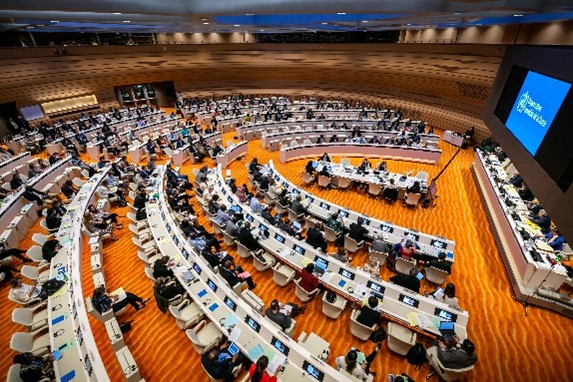
By Gilliane McShane and Valentina Pomatto for ReLAB-HS
After years of efforts to bring rehabilitation into the fold of what is considered essential health care, rehabilitation advocates saw the successful adoption of the first ever international resolution on rehabilitation at the Seventy-Sixth World Health Assembly on May 24, 2023. This resolution aspires to expand and integrate rehabilitation services at all levels of health care by calling on national and international actors to strengthen health systems for the sustained provision of these essential services.
The passing of this resolution, “Strengthening rehabilitation in health systems,” is a result of concerted international efforts by World Health Organization (WHO) Member States and civil society organizations. Through our advocacy efforts, Learning, Acting, and Building for Rehabilitation in Health Systems (ReLAB-HS) engaged with global rehabilitation stakeholders and Member States to build consensus around the need for this global initiative.
Recognizing rehabilitation as essential health care
Though the resolution is not legally binding, it serves as the highest-level commitment toward rehabilitation, providing a policy framework to guide efforts to strengthen rehabilitation and its integration into health systems. The resolution outlines commitments that Member States, other stakeholders (e.g., nongovernmental organizations, academia, and the private sector), and the WHO can work toward, such as strengthening financing mechanisms, and establishes reporting and monitoring systems to promote accountability and spur action.
The move to adopt this resolution is profound. It is estimated that 2.4 billion people globally would benefit from rehabilitation, and in low- and middle-income countries, more than 50 percent of people do not receive the rehabilitation services they require—a need that continues to grow due to injury and illness from communicable and noncommunicable disease. Until now, rehabilitation had not been prioritized in the global health agenda in such a meaningful way.
Prioritizing rehabilitation demonstrates a commitment to health that goes beyond reducing mortality and morbidity. It helps ensure that people can live, function, and participate fully in life. Without access to rehabilitation services, health conditions can deteriorate or lead to additional complications, reducing a person’s ability to participate in work, education, and other aspects of daily living. Investing in rehabilitation is strategic as it yields both social and economic benefits.
The adoption of the resolution signals an important shift to recognizing rehabilitation as integral to Universal Health Coverage (UHC) and demonstrates the political commitment to mobilize efforts and allocate resources to improve service availability and accessibility.
Building consensus, demonstrating commitment
ReLAB-HS is proud to have played an active role in advocating for and developing the resolution on rehabilitation. Our goal, “Support the strengthening of health systems that are responsive to growing needs for rehabilitation across the lifespan,” is aligned with the resolution on rehabilitation, and our activities and continued efforts will support the implementation of the resolution in our focus countries by:
Beyond these core initiatives, we will conduct activities specifically designed to support local and national advocacy for the implementation of the resolution, which include:
The World Health Assembly’s adoption of the resolution on rehabilitation serves as a critical step toward framing the role of rehabilitation in the global health agenda. This formal recognition by the World Health Assembly elevates rehabilitation and frames commitments to take action. Political will is central to successful implementation and must also be accompanied by leadership at all levels of the health systems, in communities, and in overlapping sectors to develop a shared vision, build momentum, and coordinate efforts to effect meaningful change.